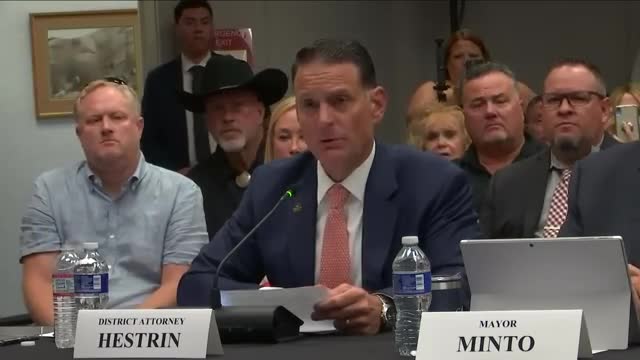Riverside County battles escalating fentanyl crisis from Mexico
September 06, 2024 | Judiciary: House Committee, Standing Committees - House & Senate, Congressional Hearings Compilation
This article was created by AI summarizing key points discussed. AI makes mistakes, so for full details and context, please refer to the video of the full meeting. Please report any errors so we can fix them. Report an error »

Riverside County, situated east of Los Angeles and north of San Diego, is grappling with severe challenges related to drug trafficking and illegal immigration, primarily due to its proximity to the US-Mexico border. The county has become a significant corridor for drug trafficking, particularly for fentanyl, with major freeways like Interstate 15 serving as critical routes for traffickers moving illicit substances into Southern California and beyond.
Recent law enforcement operations highlight the escalating crisis. On August 20, US Border Patrol agents seized 81 pounds of cocaine during a traffic stop on Interstate 15 in Temecula. Additionally, the newly established Nasrack Border Patrol Station in Murrieta reported seizing over 2,400 pounds of cocaine this fiscal year, alongside significant quantities of methamphetamine, heroin, and fentanyl. Nationally, fentanyl seizures have surged, with US Customs and Border Protection reporting over 11,000 pounds seized in fiscal year 2021—nearly double the amount from the previous year.
The impact of fentanyl on Riverside County is profound, prompting local authorities to investigate every fentanyl-related death as a potential homicide. Since 2021, the district attorney's office has filed over 30 homicide charges related to fentanyl, including a notable conviction in the case of People versus Romero, which resulted in a 15-year-to-life sentence for second-degree murder.
Despite these efforts, the fentanyl crisis continues to escalate. The drug is primarily produced in Mexico by the Sinaloa and Jalisco cartels, which are increasingly targeting children through social media and lacing other drugs with fentanyl. Alarmingly, the proportion of illicit drug pills containing fentanyl has risen from 40% in 2021 to 70% today.
Local officials are calling for urgent federal action to combat this crisis, emphasizing the need for stronger border policies and enhanced law enforcement resources. They argue that the fight against fentanyl trafficking cannot be managed by local authorities alone and that comprehensive federal initiatives are essential to curb the influx of this lethal substance into their communities.
Recent law enforcement operations highlight the escalating crisis. On August 20, US Border Patrol agents seized 81 pounds of cocaine during a traffic stop on Interstate 15 in Temecula. Additionally, the newly established Nasrack Border Patrol Station in Murrieta reported seizing over 2,400 pounds of cocaine this fiscal year, alongside significant quantities of methamphetamine, heroin, and fentanyl. Nationally, fentanyl seizures have surged, with US Customs and Border Protection reporting over 11,000 pounds seized in fiscal year 2021—nearly double the amount from the previous year.
The impact of fentanyl on Riverside County is profound, prompting local authorities to investigate every fentanyl-related death as a potential homicide. Since 2021, the district attorney's office has filed over 30 homicide charges related to fentanyl, including a notable conviction in the case of People versus Romero, which resulted in a 15-year-to-life sentence for second-degree murder.
Despite these efforts, the fentanyl crisis continues to escalate. The drug is primarily produced in Mexico by the Sinaloa and Jalisco cartels, which are increasingly targeting children through social media and lacing other drugs with fentanyl. Alarmingly, the proportion of illicit drug pills containing fentanyl has risen from 40% in 2021 to 70% today.
Local officials are calling for urgent federal action to combat this crisis, emphasizing the need for stronger border policies and enhanced law enforcement resources. They argue that the fight against fentanyl trafficking cannot be managed by local authorities alone and that comprehensive federal initiatives are essential to curb the influx of this lethal substance into their communities.
View full meeting
This article is based on a recent meeting—watch the full video and explore the complete transcript for deeper insights into the discussion.
View full meeting